

Pierre Belon. Popular Science Monthly/Volume 34/March 1889/Sketch of Pierre Belon. "IN 1555" says M.
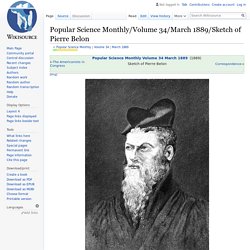
Louis Crié, "Pierre Belon, of Mans, well known by his travels in Italy, Greece, and the East, revealed himself as an observer of great sagacity and as a bold thinker. With him came at once the end of compilation and the beginning of observation. He added to the common treasure of knowledge more wealth than all his predecessors from antiquity and all his contemporaries put together. " M. AramcoWorld : The Busbecq Letters. Ogier Ghiselin de Busbecq. Ogier Ghiselin de Busbecq (1522 in Comines – 28 October 1592; Latin: Augerius Gislenius Busbequius; sometimes Augier Ghislain de Busbecq) was a 16th-century Flemish writer, herbalist and diplomat in the employ of three generations of Austrian monarchs.
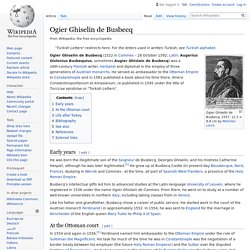
He served as ambassador to the Ottoman Empire in Constantinople and in 1581 published a book about his time there, Itinera Constantinopolitanum et Amasianum, re-published in 1595 under the title of Turcicae epistolae or "Turkish Letters". Early years[edit] Labillardière and the Botany of the Levant. Labillardiere, Jacques Julien Houtton de.

Icones plantarum Syriæ rariorum. Decas Primas. 1791. Engraving after Henri-Joseph Redouté. Contributed in the Biodiversity Heritage Library from Royal Botanic Gardens Kew, Library, Art & Archives. Leonhard Rauwolf. Leonhard Rauwolf (also spelled Leonhart Rauwolff) (21 June 1535 – 15 September 1596) was a German physician, botanist, and traveller.
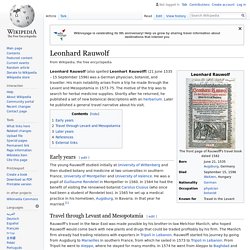
His main notability arises from a trip he made through the Levant and Mesopotamia in 1573-75. The motive of the trip was to search for herbal medicine supplies. Shortly after he returned, he published a set of new botanical descriptions with an herbarium. Later he published a general travel narrative about his visit. Early years[edit] Herbarium L. Rauwolff (1535-1596) in Leiden. The Rauwolf Herbarium: lecture Tinde van Andel. Rauwolf: Unlocking the doors of the Leiden treasure rooms. Which plants are depicted, described or collected in these century-old objects?
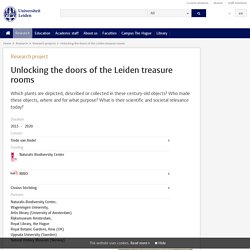
Who made these objects, where and for what purpose? What is their scientific and societal relevance today? The treasure rooms of Naturalis Biodiversity Center and the Leiden University Library contain magnificent old books and herbaria with dried plant specimens, botanical drawings, and thousands of glass jars with roots, seeds and barks, collected from the 16th to the 19th century.
Our major study objects are: The herbaria of Leonhard Rauwolf (1560-1576), collected in southern France, Italy, Lebanon, Syria and Iraq. Icones Plantarum Malabaricarum 18th century botanical drawings from Sri Lanka. Rauwolf: 16th-century herbarium research. Published on 13 March 2018 In March 2018 with the support of the Van de Sande Foundation Dr.

Abdolbaset Ghorbani Dahaneh (Uppsala University) will research the sixteenth-century Rauwolff Herbarium and its botanical sources in Leiden University Libraries. On Wednesday, March 14, during the Clusius Symposium Ghorbani will give a lecture on 'The Syrian Rauwolff Herbarium (1574)'. Joseph Pitton de Tournefort. Joseph Pitton de Tournefort (5 June 1656 – 28 December 1708) was a French botanist, notable as the first to make a clear definition of the concept of genus for plants.
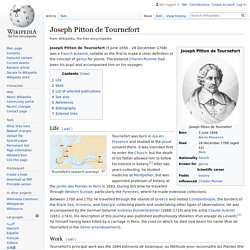
The botanist Charles Plumier had been his pupil and accompanied him on his voyages. Life[edit] Tournefort's research journeys. Sir George Wheler (1651-1724) - A Journey into Greece. WHELER, George. A Journey into Greece… In Company of Dr Spon of Lyons. In six Books. Containing I…, II…, III…, IV…, V…, VI…, London, William Cademan, Robert Kettlewell and Awnsham Churchill, 1682. - TRAVELLERS' VIEWS - Places – Monuments – People Southeas.
George Wheler (1650-1723) was born in the Netherlands to a royalist English family that had fled Cromwellian England.
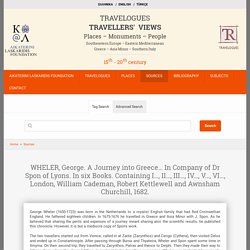
He fathered eighteen children. In 1675-1676 he travelled in Greece and Asia Minor with J. Spon. As he believed that sharing the perils and expenses of a journey meant sharing also the scientific results, he published this chronicle. However, it is but a mediocre copy of Spon's work. Levant. The term entered English in the late 15th century from French.[3] It derives from the Italian Levante, meaning "rising", implying the rising of the sun in the east.[2][4] As such, it is broadly equivalent to the term Al-Mashriq (Arabic: اَلْـمَـشْـرِق, [ʔalmaʃriq])[5], meaning "the land where the sun rises".
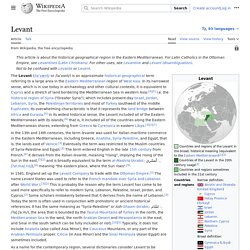
The Levant has been described as the "crossroads of western Asia, the eastern Mediterranean, and northeast Africa",[19] and the "northwest of the Arabian plate".[20] The populations of the Levant[21][22] share not only the geographic position, but cuisine, some customs, and a very long history. They are often referred to as Levantines.[23] Etymology The notion of the Levant has undergone a dynamic process of historical evolution in usage, meaning, and understanding. While the term "Levantine" originally referred to the European residents of the eastern Mediterranean region, it later came to refer to regional "native" and "minority" groups.[27]
Icones plantarum Syriæ rariorum : descriptionibus et observationibus illustratæ / Title Icones plantarum Syriæ rariorum : descriptionibus et observationibus illustratæ / By Labillardiere, Jacques Julien Houtton de 1755-1834 1755 1834.
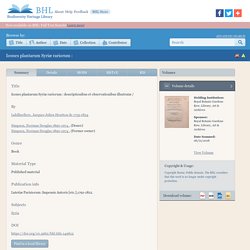
Canadian Botanical History. Long before formal study of plants began in Canadian academic institutions, they were studied by explorers and talented amateurs. Dawson, Sir John William Sir John William Dawson was the first Canadian scientist with a worldwide reputation (courtesy Library and Archives Canada/C-49822). Botany History Long before formal study of plants began in Canadian academic institutions, they were studied by explorers and talented amateurs. The vegetation of Canada was first known through descriptive reports of travellers, then through the exporting of seeds and bulbs for cultivation in Europe, and finally through collection and distribution of herbarium specimens. Exploration The first references are a few names in vernacular in Icelandic sagas; the Norse are now known to have travelled as far as northern Newfoundland, Labrador and Baffin Island.
In 1623 a series of 27 Canadian species were given scientific names by C. The John Clayton Herbarium. Catesby. Early eighteenth-century North America was an exotic place for British naturalists to explore. Regular links between London and the New World meant all manner of natural history treasures were being brought back to London. Mark Catesby (? 1682-1749) was one of many naturalists who sent objects from North America to Europe. The Englishman Mark Catesby made his first visit to North America between 1712 and 1715 and resided mainly in Virginia. SciArt Methodology: Mark Catesby. The Natural History of Carolina, Florida, and the Bahama Islands (1729-1771) by Mark Catesby, a self-taught artist and naturalist, was first publication to describe scientifically the flora and fauna of North America.
The first edition, published between 1729-1731, was written and illustrated by Catesby, with the exception of a few plates done by Georg Dionysius Ehret. Catesby arrived May 23, 1722 in Charlestown in the colony of Carolina. A passionate explorer without formal scientific training, he taught himself scientific observation, illustration, and engraving. He describes his scientific and artistic methodology with much humility. Botanica Caroliniana: Catesby. Summary: An evolving digital library focused on the botanical history of the Carolinas. Focuses of research are digital imagery of botanical specimens from the Sloane Herbarium in London, with associated electronic texts, data collections, and indices. This project uses the CITE Infrastructure, developed by the Homer Multitext (C.
Dué & M. Catesby Hortus Siccus and Natural History. Amy Hackney Blackwell, Christopher W. Blackwell. André Thevet. André Thevet (French: [təvɛ]; 1516 – 23 November 1590) was a French Franciscan priest, explorer, cosmographer and writer who travelled to Brazil in the 16th century. History of European botanical discoveries in China (1898) William Bentinck, 1st Earl of Portland. Boym: Flora sinensis. If you are generating a PDF of a journal article or book chapter, please feel free to enter the title and author information. The information you enter here will be stored in the downloaded file to assist you in managing your downloaded PDFs locally. Thank you for your request. Please wait for an email containing a link to download the PDF.
For your reference, the confirmation number for this request is . The British Library MS Viewer. The British Library MS Viewer. Georg Joseph Kamel. Plants named after Kamel[edit] Paul Hermann’s Ceylon Herba...1679) at Leiden, the Netherlands: Ingenta Connect Fast Track Article. Paul Hermann (botanist) Paradisus batavus by Paul Hermann, Leyden, 2nd Edn. 1705. Naturalis Newsroom 23: The lost plants of Rumphius.
Kaempfer: Amoenitatum exoticarum politico-physico-medicarum fasciculi V … « Bibliotheca Sinica 2.0. Kaempfer: Amoenitatum Exoticarum Politico-Physico-Medicarum Fasciculi V - GDZ. Icones Plantarum Malabaricarum: Early 18th century botanical drawings of medicinal plants from colonial Ceylon. JavaScript is disabled on your browser. Please enable JavaScript to use all the features on this page. Abstract. About - The Lawson Trek. Cinnamon’s Spicy History. Cinnamon has been in use by humans for thousands of years—possibly as early as 2,000 B.C. Cinnamon has been in use by humans for thousands of years—as early as 2,000 B.C.
Cuninghame. Botanical treasures of China. In 1699 James Cuninghame, a Scottish ship’s surgeon, returned to Britain from a trading voyage to Xiamen (then known as Amoy) on the East coast of China, with a set of nearly eight hundred botanical watercolours, painted on forty-three large sheets of paper. General History of the Things of New Spain by Fray Bernardino de Sahagún: The Florentine Codex. Dumbarton Oaks Acquires Important Works Contributing to Study of the Nahua Language and the Natural History of Mexico — Dumbarton Oaks. Francisco Hernández expedition (1570–77) Francisco Hernández de Toledo. RECCHI, Nardo Antonio in "Dizionario Biografico" Nicolás Monardes 1493-1588. Johan Maurits 1604-1679. José Celestino Mutis Facts. Historia Naturalis Brasiliae copy census: final call (Updated)
Gonzalo Fernández de Oviedo y Valdés 1478-1557. José de Acosta 1539/40-1600. Charles Plumier. CATHOLIC ENCYCLOPEDIA: Charles Plumier. Códices de mexico. Madrid BG: Expedition Collections. Monciño and de Candolle. Real Jardín Botanico de Madrid - Página principal. Cristobal Acosta: History and Science of Indian Systems of Knowledge. Cristobal Acosta: The Galileo Project.